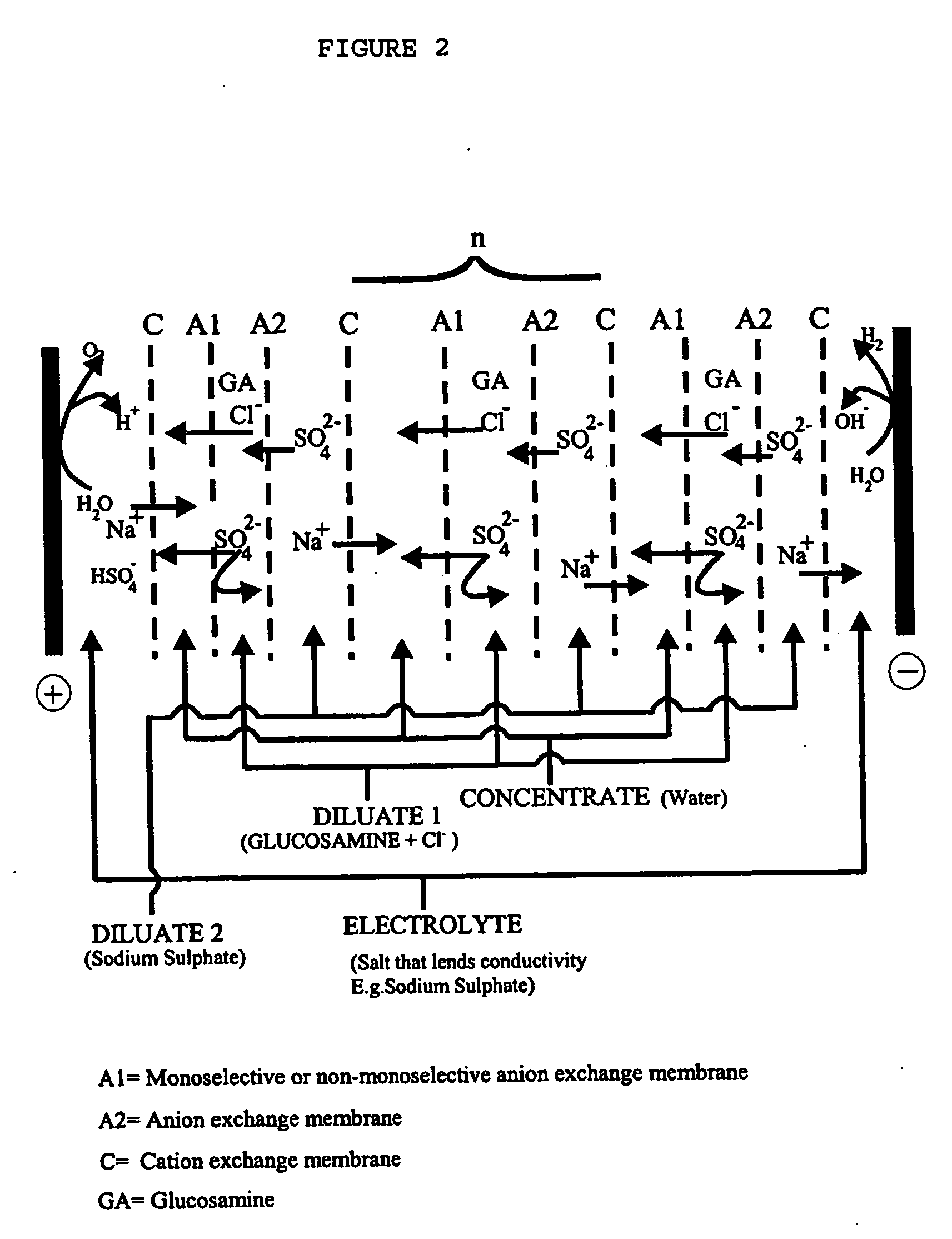Process for the preparation of glucosamine salts
a technology of glucosamine salt and process, which is applied in the field of process for the preparation of glucosamine salt, can solve the problems of low production yield and toxic substances such as triethylamine, and achieve the effect of less cost and more profitable process
- Summary
- Abstract
- Description
- Claims
- Application Information
AI Technical Summary
Benefits of technology
Problems solved by technology
Method used
Image
Examples
example 1
Preparation of Glucosamine Sulphate According to the Process of FIG. 2 (Current Intensity 10 A).
A stack of electrodialysis was set up (according to FIG. 2) with two electrodes and 10 unit cells, the anode being composed of Ti—Pt and the cathode of stainless steel. The unit cell is comprised of two anion exchange membranes that allow all anions to pass through (Tokuyama Neosepta AMX) and a cation exchange membrane that allows all cations to pass through (Tokuyama Neosepta CMX).
Next, the glucosamine hydrochloride and sodium sulphate solutions were prepared.
10 L of a 17% (w / v) glucosamine hydrochloride solution were prepared and loaded in a PVC tank used to feed the diluate 1.
The electrolyte solution, consisting of 2 L of a 1.4% (w / w) sodium sulphate solution was prepared. Once prepared, it was loaded in a tank used to feed the electrolyte.
The diluate 2 solution, consisting of 20 L of 10% (w / v) sodium sulphate, was prepared. Once prepared, it was loaded in the tank used to fe...
example 2
Preparation of Glucosamine Sulphate According to the Process of FIG. 2 (Current Intensity 14 A).
The process in Example 1 was followed, but in this case 10 L of 21% glucosamine hydrochloride, 2 L of a 1.4% (w / w) sodium sulphate solution as electrolyte solution and a current intensity of 14 A were used, setting a difference of potential between both electrodes of 50 V.
The diluate solution was subjected to a lyophilisation process in order to obtain the solid product (glucosamine sulphate), a white-Coloured solid (yield higher than 95%), with a melting point of 128° C. with decomposition being obtained.
The product obtained, as regards analytical and spectroscopic results, is equivalent to the product obtained in Example 1.
example 3
Glucosamine Sulphate Preparation According to the Process of FIG. 1 (Monoselective Anion Exchange Membranes and Cation Exchange Membranes)
A Eurodia EUR 6-80 stack of electrodialysis was used (according to FIG. 1). The stack consisted of 80 unit cells, with a total active surface area of 4.4 m2.
The cation exchange membrane used was the Tokuyama Soda CMX-SB and the anion exchange membrane was the Tokuyama Soda ACS. Eurodia DSE was used as the anode and cathode.
The resulting system has three compartments: diluate, concentrate and electrolyte.
Next, the solutions to feed the diluate and electrolyte were prepared.
A solution with 9.2 Kg of glucosamine hydrochloride and 38.4 Kg of water, and sulphuric acid until reaching 4.9% (w / w), was used for the diluate. 500 L of decalcified water were initially used for the concentrate. A 1.4% (w / w) solution of sodium sulphate was used for the electrolyte.
The experiment was carried out at room temperature with the following program of diffe...
PUM
| Property | Measurement | Unit |
|---|---|---|
| Temperature | aaaaa | aaaaa |
| Fraction | aaaaa | aaaaa |
| Fraction | aaaaa | aaaaa |
Abstract
Description
Claims
Application Information
 Login to View More
Login to View More - R&D Engineer
- R&D Manager
- IP Professional
- Industry Leading Data Capabilities
- Powerful AI technology
- Patent DNA Extraction
Browse by: Latest US Patents, China's latest patents, Technical Efficacy Thesaurus, Application Domain, Technology Topic, Popular Technical Reports.
© 2024 PatSnap. All rights reserved.Legal|Privacy policy|Modern Slavery Act Transparency Statement|Sitemap|About US| Contact US: help@patsnap.com









